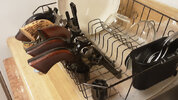westernrover
Member
- Joined
- May 4, 2018
- Messages
- 1,613
I've reloaded smokeless for some time. I'm contemplating loading some cartridges with gunpowder (black powder). Should I plan to fire these in my 357 New Vaquero, or should I think about getting another gun for gunpowder?
My Vaquero has a beautiful highly polished blue finish and all my guns I keep very clean. Will I regret firing gunpowder in it?
I'm not afraid to strip revolvers, though it isn't an appealing task for every time I fire it. I've seen video of people cleaning BPCR's with water and Ballistol without stripping them (just removing the cylinder).
I wonder if I wouldn't rather have another gun for gunpowder, maybe even a stainless-steel Vaquero. Another option I'm considering is loading brass shotshells with gunpowder for my single-shot Henry 20 ga. I think that would keep most of the fouling in the smooth bore that would be pretty easy to clean.
My Vaquero has a beautiful highly polished blue finish and all my guns I keep very clean. Will I regret firing gunpowder in it?
I'm not afraid to strip revolvers, though it isn't an appealing task for every time I fire it. I've seen video of people cleaning BPCR's with water and Ballistol without stripping them (just removing the cylinder).
I wonder if I wouldn't rather have another gun for gunpowder, maybe even a stainless-steel Vaquero. Another option I'm considering is loading brass shotshells with gunpowder for my single-shot Henry 20 ga. I think that would keep most of the fouling in the smooth bore that would be pretty easy to clean.




